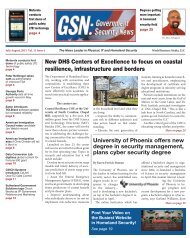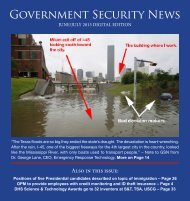GSN Digital Edition April 2016
You also want an ePaper? Increase the reach of your titles
YUMPU automatically turns print PDFs into web optimized ePapers that Google loves.
Hazmat Science and Public Policy with George Lane<br />
Race for a New Class of Weapons<br />
Threatens to Revive Cold War<br />
By George Lane<br />
The U.S., Russia, and China are currently<br />
aggressively pursuing a new<br />
generation of smaller, less destructive<br />
weapons, using “hypersonic glide” vehicles<br />
(HGV). The buildups threaten<br />
to revive a Cold War-era arms race<br />
and unsettle the balance of destructive<br />
force among nations that has kept<br />
the peace for more than a half-century.<br />
It is an old dynamic playing out<br />
in an economically declining Russia,<br />
a rising China, and an<br />
uncertain U.S. resuming<br />
their brinksmanship.<br />
U.S .officials blame<br />
Russian president Putin.<br />
Some blame the Chinese,<br />
who are looking for<br />
a technological edge to<br />
keep the U.S. at bay. And some blame<br />
the U.S. for speeding ahead with<br />
“modernization” that risks throwing<br />
nuclear fuel on the fire.<br />
“Fast, precise, and deadly”<br />
HGVs are being developed by the<br />
U.S., China, and Russia, ultrahighspeed<br />
warheads capable of carrying<br />
either nuclear or non-nuclear payloads.<br />
As in the graphic, the HGV vehicle<br />
is launched in several stages: (1)<br />
Moscow and Beijing are testing space<br />
weapons that could knock out U.S.<br />
military satellites at the beginning of<br />
a nuclear war.<br />
Launch; (2) Separation; (3) Descent;<br />
(4) Pull up; (5) Glide; and (6) Impact.<br />
The HGV is launched aboard an<br />
ICBM, separates while still in space,<br />
and then zooms back into the atmosphere<br />
at Mach 10, or 7,680 miles<br />
per hour. That’s fast enough to enter<br />
American airspace before we even<br />
react. By comparison, today’s cruise<br />
missiles fly between 500 to 600 mph.<br />
The HGV is less susceptible to anti-ballistic<br />
missile countermeasures<br />
than conventional reentry vehicles<br />
that descend on a predictable ballistic<br />
trajectory. HGVs could pull-up<br />
after reentering the atmosphere and<br />
approach its target in a relatively flat<br />
glide, lessening the time it can be detected,<br />
fired at, or reengaged if the<br />
initial attack failed. Gliding makes it<br />
more maneuverable and also extends<br />
its range so that relatively vulnerable<br />
mid-course phase of its flight can take<br />
10<br />
place father from the target.<br />
The HGV stays within the stratosphere<br />
after reentry and pull-up, and<br />
glides through the air. Although that<br />
creates more drag, warheads fly further<br />
than they would on a higher trajectory<br />
through space, and are too low<br />
to be intercepted by exo-atmospheric<br />
kill vehicles.<br />
The Chinese military is flight-testing<br />
a HGV called “WU-14”. It flies<br />
into space on a traditional<br />
long-range missile, but<br />
then maneuvers through<br />
the atmosphere at Mach 10,<br />
rendering current missile<br />
defenses useless. WU-14<br />
would provide Beijing for<br />
the first time with a precision<br />
strike capability to hit any target<br />
in the world within an hour.<br />
China might use their HGV as an<br />
anti-ship ballistic missile with a nonnuclear<br />
warhead against U.S. aircraft<br />
carriers and alter the balance of<br />
power in the Pacific, where China is<br />
literally building new islands in the<br />
South China Sea, also claimed by at<br />
least three other countries, including<br />
the Philippines, an American ally. The<br />
Chinese have concluded that it is un-
















